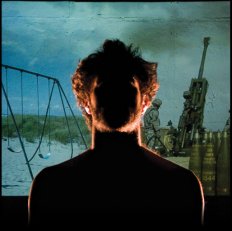 It might seem odd to apply the term “understated” to a documentary that features gritty combat footage: gunfire- and explosion-wracked images from conflicts that include the Sandinista Revolution in Nicaragua and America’s intervention in Somalia in the 1990s. But a quiet, poignant restraint is a key note of Hidden Battles, a graceful study of how the act of killing affects soldiers’ mental health. A recent showpiece on the film festival circuit, Hidden Battles interweaves encounters with five fighters who have experienced long-term repercussions of using lethal force. Sensationalism is virtually absent, war footage aside: the documentary contains no explicit accounts of domestic crises, no interviews with therapists, no solemn voiceovers weighing in on posttraumatic stress disorder. Instead, it suggests emotional and spiritual turmoil by more subdued means: close-ups on interviewees struggling to find words; a view of a veteran punctiliously cleaning her already gleaming refrigerator; a shot of a onetime Vietnam G.I. gently petting a cat.
It might seem odd to apply the term “understated” to a documentary that features gritty combat footage: gunfire- and explosion-wracked images from conflicts that include the Sandinista Revolution in Nicaragua and America’s intervention in Somalia in the 1990s. But a quiet, poignant restraint is a key note of Hidden Battles, a graceful study of how the act of killing affects soldiers’ mental health. A recent showpiece on the film festival circuit, Hidden Battles interweaves encounters with five fighters who have experienced long-term repercussions of using lethal force. Sensationalism is virtually absent, war footage aside: the documentary contains no explicit accounts of domestic crises, no interviews with therapists, no solemn voiceovers weighing in on posttraumatic stress disorder. Instead, it suggests emotional and spiritual turmoil by more subdued means: close-ups on interviewees struggling to find words; a view of a veteran punctiliously cleaning her already gleaming refrigerator; a shot of a onetime Vietnam G.I. gently petting a cat.
Directed by Victoria Mills, a filmmaker who is also a practicing psychoanalyst, Hidden Battles works on an international canvas, including among its subjects a former Sandinista rebel, an alum of an Israeli Special Forces unit, and an erstwhile Palestinian resistance fighter. In a resonant opening sequence, the camera trolleys through the streets of a sand-colored Middle Eastern town. This is the Jenin refugee camp, home to Zachariah, a Palestinian who once led the Al-Aqsa Martyrs Brigade. The portrait of this young father encompasses some spectacular footage of a nighttime gunfight sparked by an Israeli raid on the camp. But Mills devotes more emphasis to scenes that are—on the surface—more tranquil. We see Zachariah dandle his baby daughter on his knee and talk with his son, who plays with a toy gun.
Seemingly with effort, Zachariah supplies an elliptical account of his initiation into killing. He lights a cigarette and blows smoke, his face tense. “The first time is difficult; after that, it’s normal,” he says at last, with an ambivalent smile. (Zachariah and a few other interviewees speak in their native tongues; there are English subtitles.) Later—Hidden Battles moves back and forth between its subjects, tracing an extended time period—Zachariah tries to explain what it felt like to know that he was high up on an Israeli hit list, and he remembers losing family members to regional strife. “Death and I have built a very strong relationship,” he says matter-of-factly. “We’re almost friends now.”
Other former soldiers seem to have more trouble coming to terms with their pasts. Esmeralda, a native Nicaraguan who was a Sandinista rebel in 1978-79 and later moved to New York, revisits her homeland during the course of the film. She takes the documentary crew to the scene of a battle and falls silent. “I don’t want—I never want to remember,” she says eventually. Back in the United States, she asserts that the trip has had a cathartic effect, but the healing has obviously not been complete. “Even now I can’t accept that—I mean that I murdered,” she reflects as she tends her pet parakeets.
Esmeralda is not the only interviewee to experience some catharsis, and that’s not an accident. In her director’s notes, Mills writes that she deliberately chose to follow “individuals who were functioning in their day-to-day, to show that it is possible to build a life after war.” Several of the former fighters in Hidden Battles channel their experiences into art. After news coverage of Iraq and Afghanistan awakes buried memories of his time in Vietnam, a Massachusetts resident named George takes up drawing and organizes an exhibit of veterans’ art.
More remarkable is the story of Saar, a former Israeli Special Forces officer who acknowledges that, during his army stint, he suppressed his emotions. “To kill someone—[there] is no way you can connect to your feelings,” he says. “I never thought about the person.” Today Saar has a successful career as a choreographer: in an Alvin Ailey American Dance Theater rehearsal room, he teaches a dancer a move based on a knife thrust.
Fortunately, Hidden Battles doesn’t stray into unearned touchy-feely optimism. Two decades after his stint as a sniper in Somalia, a soft-spoken landscape architect named Aaron is clearly still grappling with the aftermath. The haunted look on his face ebbs a little after he moves to Scotland, but he still suffers the occasional panic attack. Near the film’s end, he and his wife and young daughter explore a ruined castle near Edinburgh. The scene is picturesque, but you can’t help seeing in the stone fortifications a sign of humanity’s more violent and self-destructive urges.
Please email comments to [email protected] and join the conversation on our Facebook page.
Share
Previous Story
A Natural
Next Story
Go Gamecocks